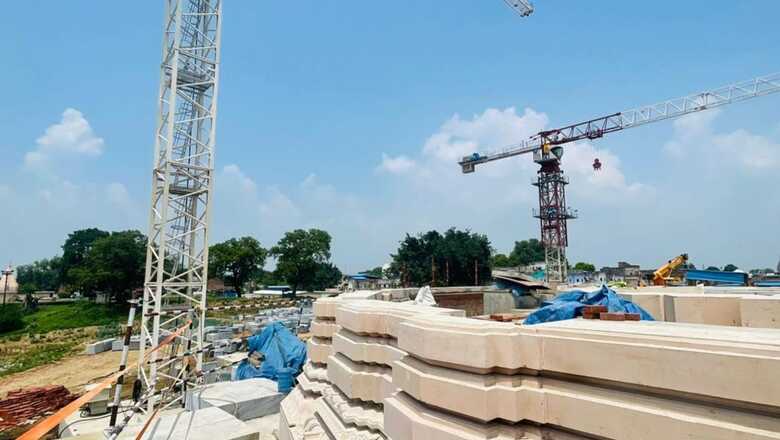
views
The construction of the three-floor superstructure of the Shri Ram Temple in Ayodhya has begun. And as per the present estimate, the total construction cost of the temple and the complex will be approximately Rs 1,800 crore, the Shri Ram Temple Trust has said.
The construction work on the three-floor superstructure comprising the Garbha Griha (sanctum sanctorum) and five mandaps (porches) on the ground floor has started in full swing, the trust said in a statement to News18. “Considering the darshan of Shri Ram Lalla to devotees will open in the month of December 2023, construction work of the Pilgrimage Facilitation Centre, other utilities and infrastructure services in the Complex have also started. As per the present estimate, the total construction cost of Temple and Complex will be approximately Rs. 1800 Crores,” the statement said.
The full trust of the Shri Ram Janmabhoomi Teerth Kshetra met on September 11 and did a detailed review of the progress.
Granite for plinth
This superstructure of the temple is being constructed on the 6.5m (21 ft) high plinth which will take its direct load. As most ancient temples were constructed on natural rocky strata, the consortium of engineers of the Shri Ram temple picked granite stone for the plinth work. The construction of the plinth, which started in February 2022, is now complete.
“Approximately 17,000 Granite stones blocks of size 5ft x 2.5ft x 3ft were used in the construction of the plinth by interlocking arrangement between the stones. The weight of each Granite stone block is approx. 3 tons. Four tower cranes, several mobile cranes & other equipment’s were deployed for the erection and laying of the Granite Stones Blocks in the Plinth. The Plinth area is approx. 3500 sq m, which will act like a solid rock. Proven and tested quality of Granite Stone was procured from mines of Karnataka and Andhra Pradesh,” the trust said in the statement.
As the large weight and size of these stones meant road transportation would be less efficient to meet the completion schedule, Container Corporation of India (a Govt of India Enterprise) and Indian Railways were engaged in the transportation of the granite, the trust said. “The Indian Railways extended full cooperation and created a green corridor for transporting the Granite Stone Blocks which reduced the completion schedule of Plinth by Two months. National Institute of Rock Mechanics (Organization under the Ministry of Mining), Bangalore was engaged as an expert for monitoring the quality of the Granite Stones at mining place as well as at Shri Ram Temple workplace,” said the statement.
Bansi Paharpur sandstone for superstructure
The superstructure of the temple is being constructed by using carved Rajasthan sandstone from Bansi Paharpur in Bharatpur district. The carving and erection work of the sandstones have started and approximately 1,200 skilled technicians are engaged at mines and workshops in Rajasthan as well as at the Shri Ram Temple workplace, the trust said. The quality of the stones and the workmanship of the carving is being supervised by experts of the National Institute of Rock Mechanics (NIRM) from Bengaluru, architect CB Sompura, and implementing agencies Larsen & Toubro Ltd (L&T) and Tata Consulting Engineers (TCE).
Approximately 4.75 lakh cubic feet of the Bansi Paharpur stones will be used in the superstructure of the temple and till now 40 per cent of them have been carved and are available for erection, the trust said. White Makrana marble from Rajasthan has been finalised for the Garbha Griha, flooring, arches, railing and door frames in the main temple. Accordingly, procurement and carving are in progress.
“The super structure of the Parkota is proposed to be constructed by using carved Red Rajasthan Sandstone from Bansi Paharpur District Bharatpur. Construction work of RCC retaining wall and foundation of Parkota is in progress as per schedule. For the convenience of devotees visiting Shri Ram Lalla Temple, Pilgrimage Facilitation Centre is being constructed. In the Pilgrimage Facilitation Centre, the facility of depositing shoes and other personal belongings, waiting halls for 5000 devotees, drinking water, toilets, and other utilities have been planned,” the trust said in the statement.
The masterplan for the remaining area of the Shri Ram Janmabhoomi complex is under finalisation in which temples of Rishi Valmiki, Acharya Vashisth, Rishi Vishwamitra, Agastya Rishi, Nishad, Jatayu, and Mata Sabri are planned in addition to other facilities like Yagya Mandap, Anusthan Mandap, Sant Niwas, Museum, Research Centre, Library, etc. The maximum focus has been given to green areas and ensuring that the complex is devotee-friendly, said the trust.
Read all the Latest News India and Breaking News here

















Comments
0 comment